Size-Activity Relationship of TiO2-Supported Pt Nanoparticles in Hydrogenation Reactions
Abstract
1. Introduction
2. Results
3. Discussion
4. Materials and Methods
4.1. Preparation of the H2PtCl6 Aqueous Solution
4.2. Preparation of the 2-Pt/TiO2 Catalyst
4.3. Preparation of the 4-Pt/TiO2 Catalyst
4.4. Preparation of the 10-Pt/TiO2 Catalyst
4.5. Preparation of the 15-Pt/TiO2 Catalyst
4.6. Preparation of the 41-Pt/TiO2 Catalyst
4.7. Catalytic Performance
5. Conclusions
Supplementary Materials
Author Contributions
Funding
Institutional Review Board Statement
Informed Consent Statement
Data Availability Statement
Conflicts of Interest
References
- Liang, S.; Hao, C.; Shi, Y. The Power of Single-Atom Catalysis. ChemCatChem 2015, 7, 2559. [Google Scholar] [CrossRef]
- Zhang, L.; Zhou, M.; Wang, A.; Zhang, T. Selective Hydrogenation over Supported Metal Catalysts: From Nanoparticles to Single Atoms. Chem. Rev. 2020, 120, 683. [Google Scholar] [CrossRef]
- Wei, J.; Iglesia, E. Mechanism and Site Requirements for Activation and Chemical Conversion of Methane on Supported Pt Clusters and Turnover Rate Comparisons among Noble Metals. J. Phys. Chem. B 2004, 108, 4094. [Google Scholar] [CrossRef]
- Kuhn, J.N.; Huang, W.; Tsung, C.-K.; Zhang, Y.; Somorjai, G.A. Structure Sensitivity of Carbon—Nitrogen Ring Opening: Impact of Platinum Particle Size from below 1 to 5 nm upon Pyrrole Hydrogenation Product Selectivity over Monodisperse Platinum Nanoparticles Loaded onto Mesoporous Silica. J. Am. Chem. Soc. 2008, 130, 14026. [Google Scholar] [CrossRef] [PubMed]
- Zhu, Z.; Tao, H.; Zhou, Y. Using Density Functional Theory To Unravel the Size-Dependent Effect of Au Nanoparticles and Au Single Atoms Adsorbed on Carbon Nitride for the Hydrogenation of Nitrobenzene. ACS Appl. Nano Mater. 2022, 5, 18753. [Google Scholar] [CrossRef]
- Vilé, G.; Albani, D.; Almora-Barrios, N.; López, N.; Pérez-Ramírez, J. Advances in the Design of Nanostructured Catalysts for Selective Hydrogenation. ChemCatChem 2016, 8, 21. [Google Scholar] [CrossRef]
- Meemken, F.; Baiker, A. Recent Progress in Heterogeneous Asymmetric Hydrogenation of C=O and C=C Bonds on Supported Noble Metal Catalysts. Chem. Rev. 2017, 117, 11522. [Google Scholar] [CrossRef] [PubMed]
- Bhogeswararao, S.; Srinivas, D. Intramolecular selective hydrogenation of cinnamaldehyde over CeO2–ZrO2-supported Pt catalysts. J. Catal. 2012, 285, 31. [Google Scholar] [CrossRef]
- Cao, Z.; Bu, J.; Zhong, Z.; Sun, C.; Zhang, Q.; Wang, J.; Chen, S.; Xie, X. Selective hydrogenation of cinnamaldehyde to cinnamyl alcohol over BN-supported Pt catalysts at room temperature. Appl. Catal. A Gen. 2019, 578, 105. [Google Scholar] [CrossRef]
- Guo, Y.; Huang, Y.; Zeng, B.; Han, B.; Akri, M.; Shi, M.; Zhao, Y.; Li, Q.; Su, Y.; Li, L.; et al. Photo-thermo semi-hydrogenation of acetylene on Pd1/TiO2 single-atom catalyst. Nat. Commun. 2022, 13, 2648. [Google Scholar] [CrossRef]
- Guo, Y.; Qi, H.; Su, Y.; Jiang, Q.; Cui, Y.-T.; Li, L.; Qiao, B. High Performance of Single-atom Catalyst Pd1/MgO for Semi-hydrogenation of Acetylene to Ethylene in Excess Ethylene. ChemNanoMat 2021, 7, 526. [Google Scholar] [CrossRef]
- Tiwari, G.; Sharma, G.; Verma, R.; Gakhad, P.; Singh, A.K.; Polshettiwar, V.; Jagirdar, B.R. Acetylene Semi-Hydrogenation at Room Temperature over Pd—Zn Nanocatalyst. Chem. A Eur. J. 2023, 29, e202301932. [Google Scholar] [CrossRef] [PubMed]
- Yang, L.; Guo, Y.; Long, J.; Xia, L.; Li, D.; Xiao, J.; Liu, H. PdZn alloy nanoparticles encapsulated within a few layers of graphene for efficient semi-hydrogenation of acetylene. Chem. Commun. 2019, 55, 14693. [Google Scholar] [CrossRef]
- Sun, S.; Du, M.; Zhao, R.; Jv, X.; Hu, P.; Zhang, Q.; Wang, B. Zn(0)-Catalysed mild and selective hydrogenation of nitroarenes. Green Chem. 2020, 22, 4640. [Google Scholar] [CrossRef]
- Li, M.; Chen, S.; Jiang, Q.; Chen, Q.; Wang, X.; Yan, Y.; Liu, J.; Lv, C.; Ding, W.; Guo, X. Origin of the Activity of Co–N–C Catalysts for Chemoselective Hydrogenation of Nitroarenes. ACS Catal. 2021, 11, 3026. [Google Scholar] [CrossRef]
- Shi, H.; Dai, X.; Liu, Q.; Zhang, T.; Zhang, Y.; Shi, Y.; Wang, T. Magnetic CuNi Alloy Nanoparticles for Catalytic Transfer Hydrogenation of Nitroarene. Ind. Eng. Chem. Res. 2021, 60, 16011. [Google Scholar] [CrossRef]
- Ishikawa, H.; Nakatani, N.; Yamaguchi, S.; Mizugaki, T.; Mitsudome, T. Robust Ruthenium Phosphide Catalyst for Hydrogenation of Sulfur-Containing Nitroarenes. ACS Catal. 2023, 13, 5744. [Google Scholar] [CrossRef]
- Yang, F.; Wang, M.; Liu, W.; Yang, B.; Wang, Y.; Luo, J.; Tang, Y.; Hou, L.; Li, Y.; Li, Z.; et al. Atomically dispersed Ni as the active site towards selective hydrogenation of nitroarenes. Green Chem. 2019, 21, 704. [Google Scholar] [CrossRef]
- Hajdu, V.; Muránszky, G.; Nagy, M.; Kopcsik, E.; Kristály, F.; Fiser, B.; Viskolcz, B.; Vanyorek, L. Development of High-Efficiency, Magnetically Separable Palladium-Decorated Manganese-Ferrite Catalyst for Nitrobenzene Hydrogenation. Int. J. Mol. Sci. 2022, 23, 6535. [Google Scholar] [CrossRef]
- Su, T.; Jiang, Y.; Xu, Y.; Luo, X.; Xie, X.; Qin, Z.; Ji, H. Ba-modified Ni-P amorphous alloy/acidified bentonite catalyst: Preparation and the catalytic hydrogenation of nitrobenzene to aniline. React. Kinet. Mech. Catal. 2020, 131, 805. [Google Scholar] [CrossRef]
- Wang, H.; Shi, F.; Pu, M.; Lei, M. Theoretical Study on Nitrobenzene Hydrogenation by N-Doped Carbon-Supported Late Transition Metal Single-Atom Catalysts. ACS Catal. 2022, 12, 11518. [Google Scholar] [CrossRef]
- Wang, W.; Wang, Y.; Zhao, X.; Li, Y.; He, H.; Lian, L.; Zeng, K.; Wu, L.; Deng, L.; Liu, Y.-N. Surface oxygen vacancies of TiO2−x enabled water transfer photocatalytic hydrogenation of nitrobenzene to aniline without use of co-catalyst. Chem. Eng. Sci. 2024, 285, 119645. [Google Scholar] [CrossRef]
- Liu, D.; Nadia, I.; Fang, C.; He, K.; Ge, B.; Chen, H.; Chen, Z. Photo enhanced catalytic activity for hydrogenation of nitrobenzene over Pt-Au/TiO2 heterojunction. Appl. Catal. A Gen. 2022, 645, 118840. [Google Scholar] [CrossRef]
- Yu, P.; Yang, Z.; Gu, Z.; Wong, H.-W. Catalytic reaction coupling of propane dehydrogenation with nitrobenzene hydrogenation over Pt/Al2O3. Catal. Commun. 2022, 166, 106449. [Google Scholar] [CrossRef]
- Jin, M.; Liu, Y.; Zhang, X.; Wang, J.; Zhang, S.; Wang, G.; Zhang, Y.; Yin, H.; Zhang, H.; Zhao, H. Selective electrocatalytic hydrogenation of nitrobenzene over copper-platinum alloying catalysts: Experimental and theoretical studies. Appl. Catal. B Environ. 2021, 298, 120545. [Google Scholar] [CrossRef]
- Xiong, W.; Wang, Z.; He, S.; Hao, F.; Yang, Y.; Lv, Y.; Zhang, W.; Liu, P.; Luo, H. Nitrogen-doped carbon nanotubes as a highly active metal-free catalyst for nitrobenzene hydrogenation. Appl. Catal. B Environ. 2020, 260, 118105. [Google Scholar] [CrossRef]
- Li, C.; Liu, S.; Yang, F.; Zhang, Y.; Gao, Z.; Yuan, X.; Zheng, X. Synthesis of γ-Al2O3–supported Pt nanoparticles using Al-based metal-organic framework as medium and their catalytic performance for total propene oxidation and selective nitrobenzene hydrogenation. Mater. Chem. Phys. 2020, 240, 122146. [Google Scholar] [CrossRef]
- Cargnello, M.; Doan-Nguyen, V.V.T.; Gordon, T.R.; Diaz, R.E.; Stach, E.A.; Gorte, R.J.; Fornasiero, P.; Murray, C.B. Control of Metal Nanocrystal Size Reveals Metal-Support Interface Role for Ceria Catalysts. Science 2013, 341, 771. [Google Scholar] [CrossRef]
- Williams, W.D.; Shekhar, M.; Lee, W.-S.; Kispersky, V.; Delgass, W.N.; Ribeiro, F.H.; Kim, S.M.; Stach, E.A.; Miller, J.T.; Allard, L.F. Metallic Corner Atoms in Gold Clusters Supported on Rutile Are the Dominant Active Site during Water—Gas Shift Catalysis. J. Am. Chem. Soc. 2010, 132, 14018. [Google Scholar] [CrossRef]
- Shekhar, M.; Wang, J.; Lee, W.-S.; Williams, W.D.; Kim, S.M.; Stach, E.A.; Miller, J.T.; Delgass, W.N.; Ribeiro, F.H. Size and Support Effects for the Water–Gas Shift Catalysis over Gold Nanoparticles Supported on Model Al2O3 and TiO2. J. Am. Chem. Soc. 2012, 134, 4700. [Google Scholar] [CrossRef]
- Shekhar, M.; Wang, J.; Lee, W.-S.; Cem Akatay, M.; Stach, E.A.; Nicholas Delgass, W.; Ribeiro, F.H. Counting Au catalytic sites for the water–gas shift reaction. J. Catal. 2012, 293, 94. [Google Scholar] [CrossRef]
- Wang, S.; Liu, Y.; Zhao, J. PtN3-Embedded graphene as an efficient catalyst for electrochemical reduction of nitrobenzene to aniline: A theoretical study. Phys. Chem. Chem. Phys. 2020, 22, 17639. [Google Scholar] [CrossRef]
- Shi, Y.; Wang, H.; Wang, Z.; Wu, T.; Song, Y.; Guo, B.; Wu, L. Pt decorated hierarchical Sb2WO6 microspheres as a surface functionalized photocatalyst for the visible-light-driven reduction of nitrobenzene to aniline. J. Mater. Chem. A 2020, 8, 18755. [Google Scholar] [CrossRef]
- Zhang, Q.; Bu, J.; Wang, J.; Sun, C.; Zhao, D.; Sheng, G.; Xie, X.; Sun, M.; Yu, L. Highly Efficient Hydrogenation of Nitrobenzene to Aniline over Pt/CeO2 Catalysts: The Shape Effect of the Support and Key Role of Additional Ce3+ Sites. ACS Catal. 2020, 10, 10350. [Google Scholar] [CrossRef]
- Macino, M.; Barnes, A.J.; Althahban, S.M.; Qu, R.; Gibson, E.K.; Morgan, D.J.; Freakley, S.J.; Dimitratos, N.; Kiely, C.J.; Gao, X.; et al. Tuning of catalytic sites in Pt/TiO2 catalysts for the chemoselective hydrogenation of 3-nitrostyrene. Nat. Catal. 2019, 2, 873. [Google Scholar] [CrossRef]
- LÜ, Z.; Zhu, S.; Dong, M.; Qin, Z.; Fan, W.; Wang, J. Synthesis of γ-Valerolactone through coupling of methyl levulinate hydrogenation with aqueous phase reforming of methanol over Pt/CoxAl catalyst. J. Fuel Chem. Technol. 2024, 52, 1266. [Google Scholar] [CrossRef]
- Dang, T.T.; Pham, V.H.; Vu, B.K.; Hur, S.H.; Shin, E.W.; Kim, E.J.; Chung, J.S. Clean and effective catalytic reduction of graphene oxide using atomic hydrogen spillover on Pt/γ-Al2O3 catalyst. Mater. Lett. 2012, 86, 161. [Google Scholar] [CrossRef]
- Lee, S.; Kim, H.; Ryoo, R.; Park, J.Y.; Choi, M. Hydrogen spillover in nonreducible oxides: Mechanism and catalytic utilization. Nano Res. 2022, 15, 10357. [Google Scholar] [CrossRef]
- Hülsey, M.J.; Fung, V.; Hou, X.; Wu, J.; Yan, N. Hydrogen Spillover and Its Relation to Hydrogenation: Observations on Structurally Defined Single-Atom Sites. Angew. Chem. Int. Ed. 2022, 61, e202208237. [Google Scholar] [CrossRef]
- Xing, S.; Xiong, M.; Zhao, S.; Zhang, B.; Qin, Y.; Gao, Z. Improving the Efficiency of Hydrogen Spillover by an Organic Molecular Decoration Strategy for Enhanced Catalytic Hydrogenation Performance. ACS Catal. 2023, 13, 4003. [Google Scholar] [CrossRef]
- Geng, Y.; Li, H. Hydrogen Spillover-Enhanced Heterogeneously Catalyzed Hydrodeoxygenation for Biomass Upgrading. ChemSusChem 2022, 15, e202102495. [Google Scholar] [CrossRef] [PubMed]
- Liu, K.; Yan, P.; Jiang, H.; Xia, Z.; Xu, Z.; Bai, S.; Zhang, Z.C. Silver initiated hydrogen spillover on anatase TiO2 creates active sites for selective hydrodeoxygenation of guaiacol. J. Catal. 2019, 369, 396. [Google Scholar] [CrossRef]
- Im, J.; Shin, H.; Jang, H.; Kim, H.; Choi, M. Maximizing the catalytic function of hydrogen spillover in platinum-encapsulated aluminosilicates with controlled nanostructures. Nat. Commun. 2014, 5, 3370. [Google Scholar] [CrossRef] [PubMed]
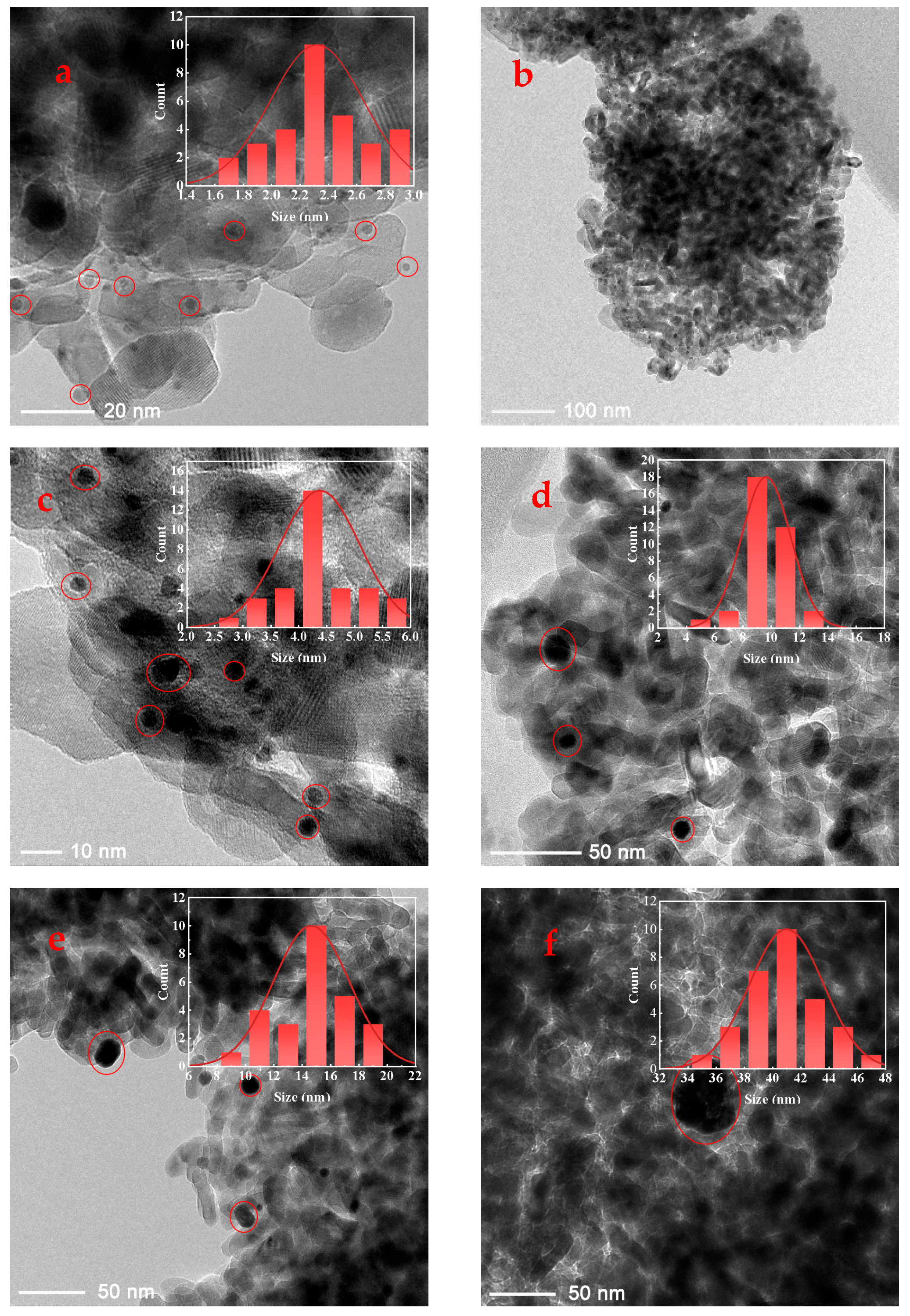
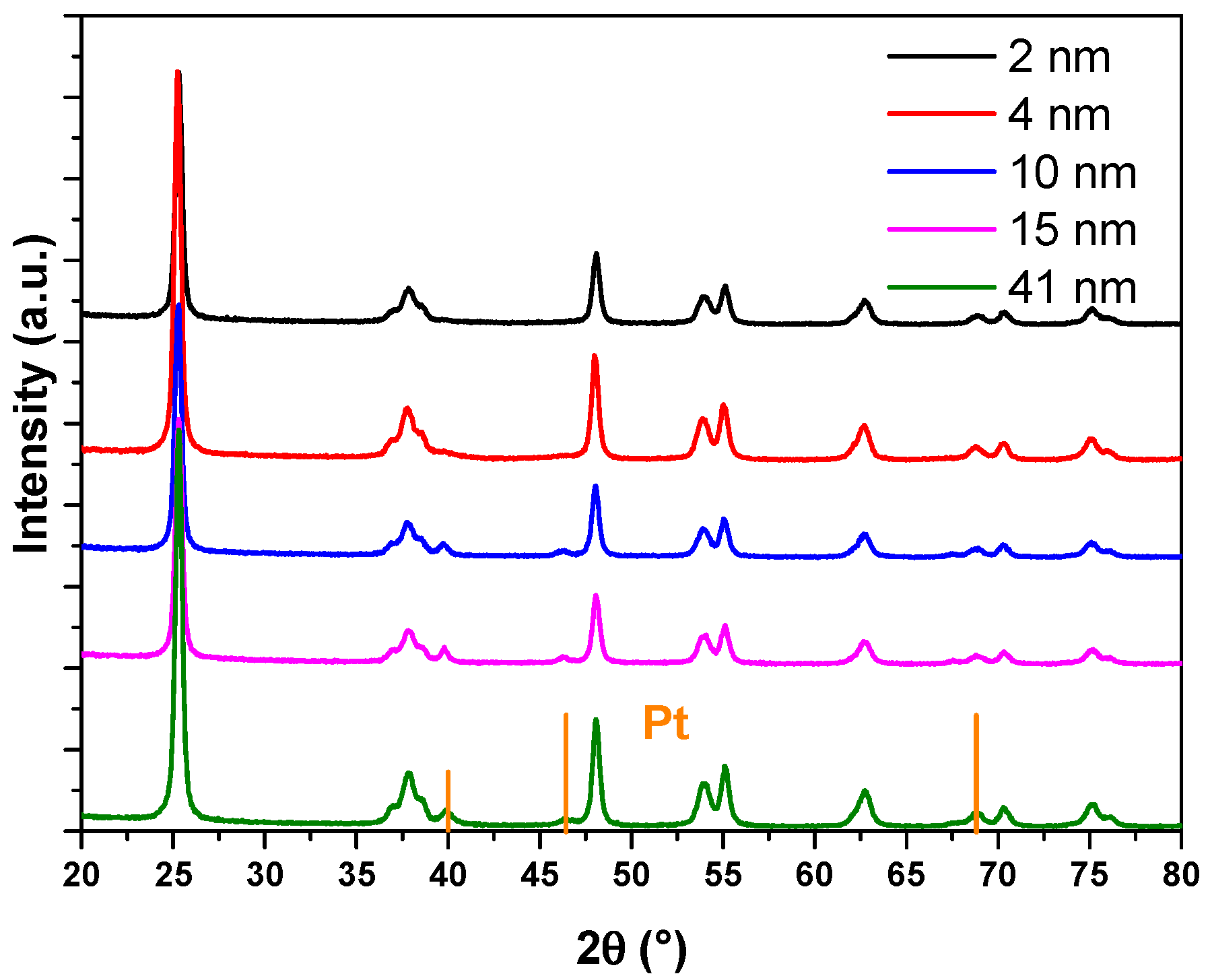

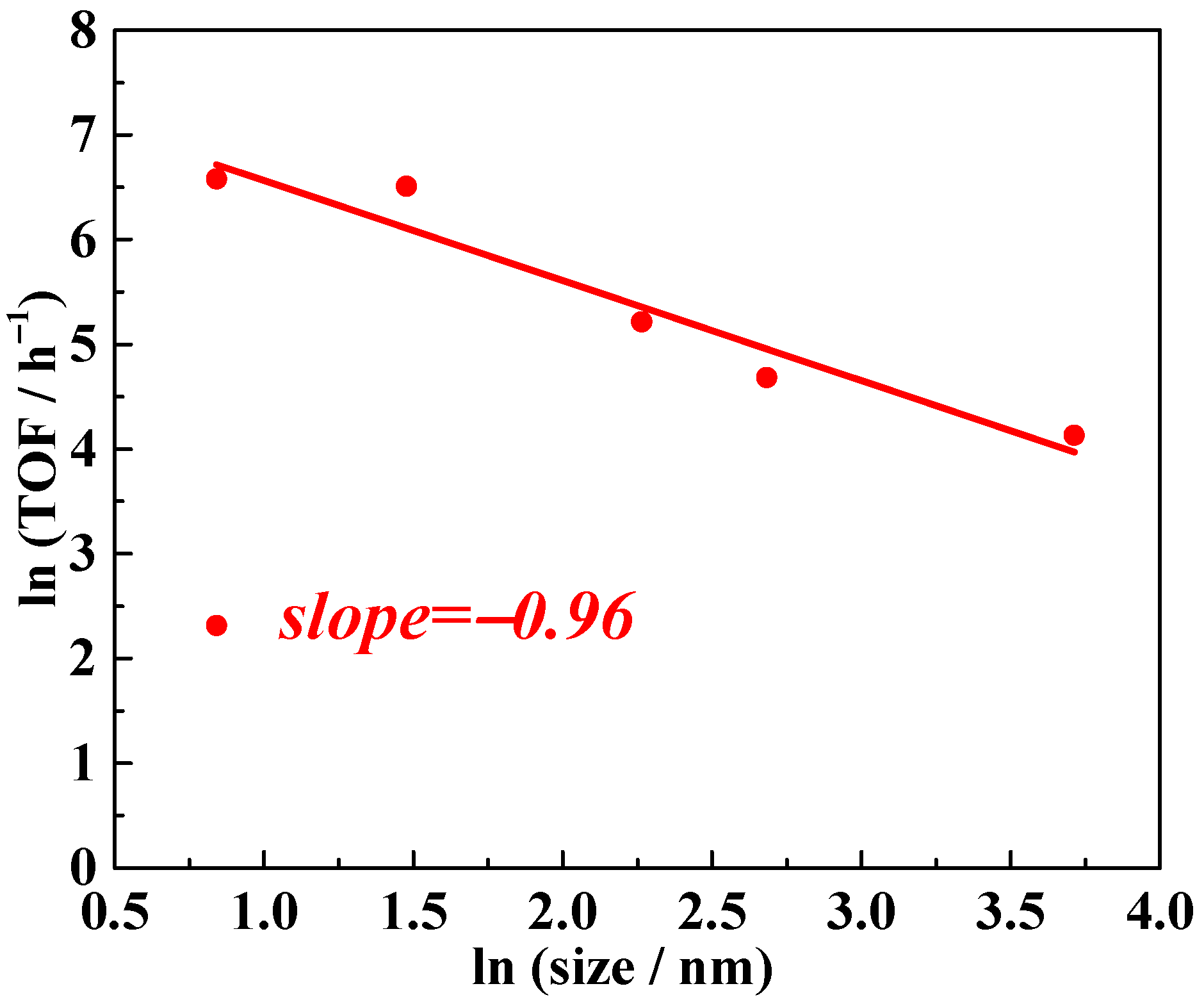
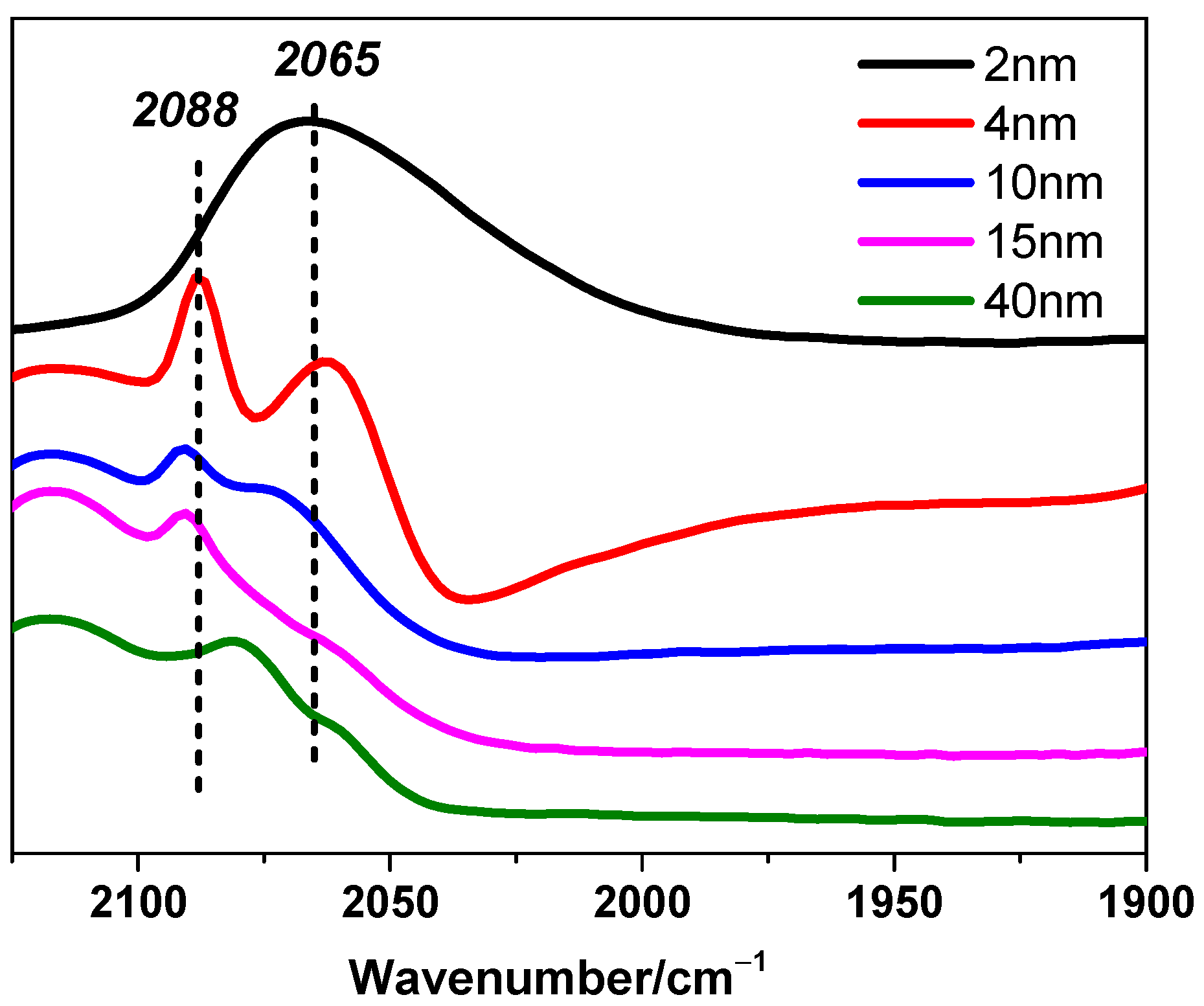
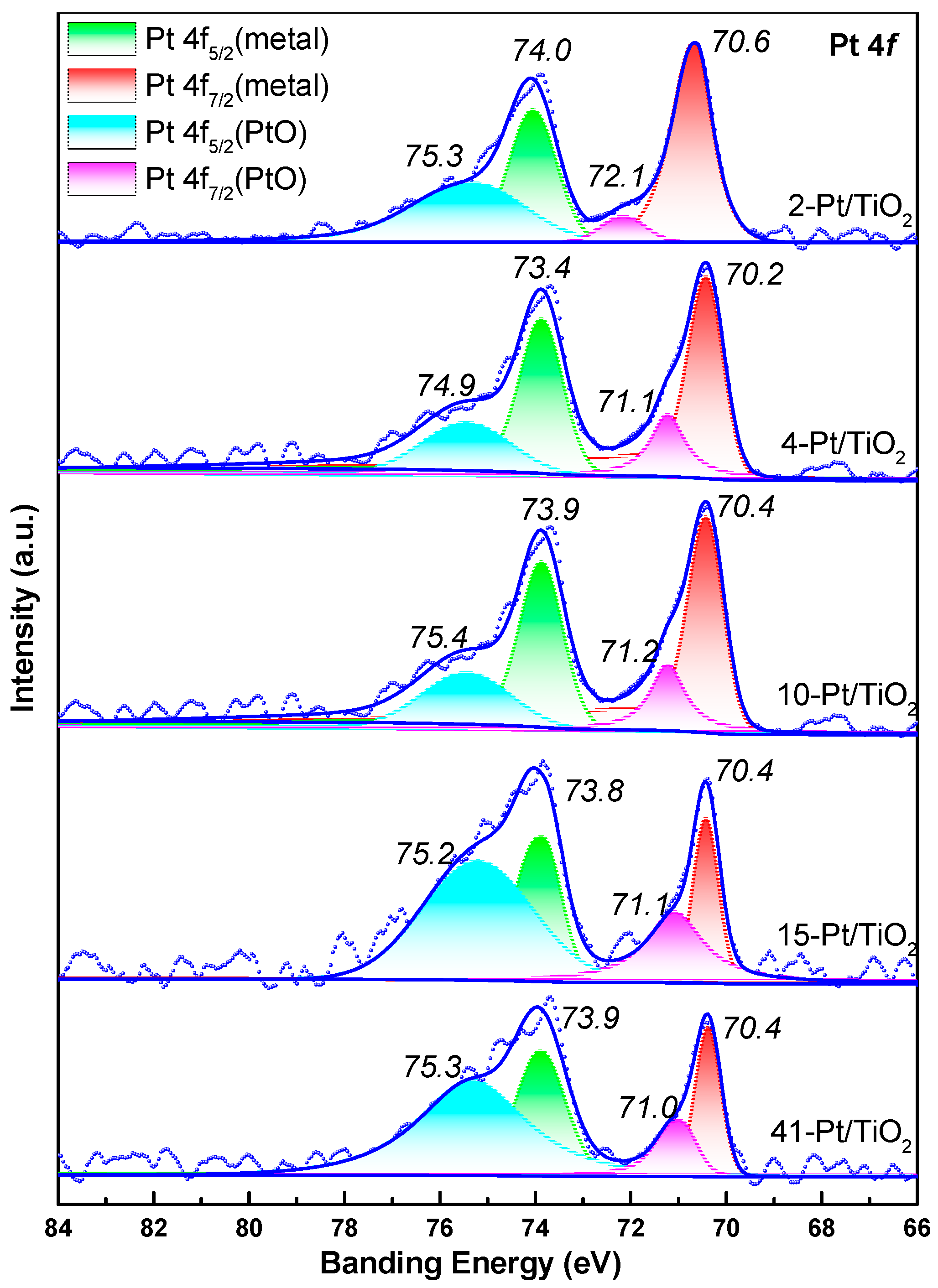

| Entry [a] | Temp. (°C) | Time (h) | Conv. (%) | TOF (h−1) |
|---|---|---|---|---|
| 1 [b] | 25 | 6 | 0 | / |
| 2 | 25 | 1 | 20.7 | 669.8 |
| 3 | 30 | 1 | 30.6 | 1012.8 |
| 4 | 35 | 1 | 34.2 | 1044.0 |
| 5 | 40 | 1 | 35.2 | 1145.5 |
| 6 | 25 | 3 | 59.8 | 644.1 |
| Entry | Catalyst | Time (h) | Conv. (%) | TOF (h−1) |
|---|---|---|---|---|
| 1 | 2-Pt/TiO2 | 1 | 22.7 | 718.3 |
| 2 | 4-Pt/TiO2 | 1 | 20.7 | 669.8 |
| 3 | 10-Pt/TiO2 | 2 | 10.7 | 184.1 |
| 4 | 15-Pt/TiO2 | 5 | 16.2 | 108.1 |
| 5 | 41-Pt/TiO2 | 5 | 9.0 | 62.2 |
| Entry | Reaction | Conv. (%) | TOF (h−1) |
|---|---|---|---|
| 1 |  | 20.7 | 669.8 |
| 2 |  | 23.5 | 508.3 |
| 3 |  | 26.1 | 372.1 |
| 4 |  | 17.4 | 1071.4 |
Disclaimer/Publisher’s Note: The statements, opinions and data contained in all publications are solely those of the individual author(s) and contributor(s) and not of MDPI and/or the editor(s). MDPI and/or the editor(s) disclaim responsibility for any injury to people or property resulting from any ideas, methods, instructions or products referred to in the content. |
© 2025 by the authors. Licensee MDPI, Basel, Switzerland. This article is an open access article distributed under the terms and conditions of the Creative Commons Attribution (CC BY) license (https://creativecommons.org/licenses/by/4.0/).
Share and Cite
Zhang, Q.; Li, T.; Min, X.-T.; Li, S.-X.; Jiang, X.; Zhang, Q.; Li, Y.; Yan, X.; Feng, R.; Yang, F.; et al. Size-Activity Relationship of TiO2-Supported Pt Nanoparticles in Hydrogenation Reactions. Inorganics 2025, 13, 186. https://doi.org/10.3390/inorganics13060186
Zhang Q, Li T, Min X-T, Li S-X, Jiang X, Zhang Q, Li Y, Yan X, Feng R, Yang F, et al. Size-Activity Relationship of TiO2-Supported Pt Nanoparticles in Hydrogenation Reactions. Inorganics. 2025; 13(6):186. https://doi.org/10.3390/inorganics13060186
Chicago/Turabian StyleZhang, Qi, Tianbo Li, Xiang-Ting Min, Shu-Xian Li, Xunzhu Jiang, Qian Zhang, Yangyang Li, Xinlong Yan, Rui Feng, Feifei Yang, and et al. 2025. "Size-Activity Relationship of TiO2-Supported Pt Nanoparticles in Hydrogenation Reactions" Inorganics 13, no. 6: 186. https://doi.org/10.3390/inorganics13060186
APA StyleZhang, Q., Li, T., Min, X.-T., Li, S.-X., Jiang, X., Zhang, Q., Li, Y., Yan, X., Feng, R., Yang, F., Zhou, W., Hu, X., Qiao, B., & Ni, Z. (2025). Size-Activity Relationship of TiO2-Supported Pt Nanoparticles in Hydrogenation Reactions. Inorganics, 13(6), 186. https://doi.org/10.3390/inorganics13060186









